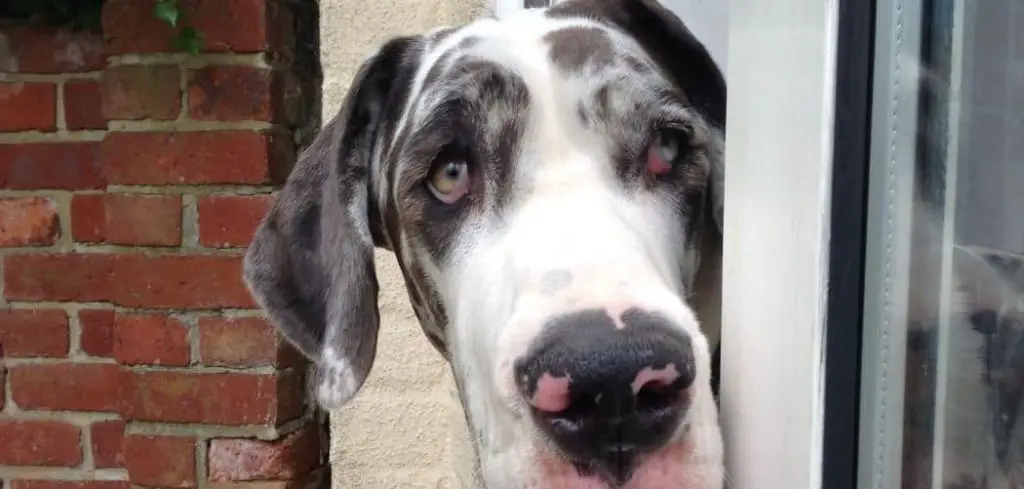As dogs age, their eyes often begin to change, leaving owners worried about cloudiness, discharge, redness, or vision problems.
Eye issues in older dogs can range from natural aging changes to serious medical conditions requiring immediate veterinary attention.
We outline the common causes of eye issues in old dogs, what you can do at home, and when to seek veterinary help.
Old Dog Eye Problems
Eye changes in senior dogs are often linked to aging, underlying health conditions, or eye-specific diseases. Cloudiness may come from cataracts or nuclear sclerosis, while tearing, redness, or squinting could signal infections, glaucoma, or dry eye disease.
Some dogs also experience vision loss due to progressive retinal atrophy or systemic illnesses like diabetes.
Because eye health impacts comfort and quality of life, noticing these changes early is important for long-term care.

Old Dog Eyes: Common Problems
Cataracts
Cataracts are one of the most well-known causes of cloudy eyes in senior dogs.
They occur when the lens inside the eye becomes opaque, leading to a whitish or bluish haze. Owners often notice that their dog’s eyes look “milky,” and vision may decline gradually.
Cataracts can be age-related, genetic, or secondary to conditions such as diabetes. Left untreated, they may progress to blindness or contribute to painful complications like glaucoma.
Read more: Old Dog Vestibular Disease (Explained)
Nuclear Sclerosis
Nuclear sclerosis, sometimes called lenticular sclerosis, is another common reason old dog eyes appear cloudy.
This condition occurs naturally with age as the lens hardens and becomes denser, creating a bluish-gray tint. Unlike cataracts, it usually doesn’t cause significant vision loss, though dogs may struggle with depth perception or seeing in low light.
While nuclear sclerosis is generally harmless, it can be mistaken for cataracts, making a veterinary eye exam essential for an accurate diagnosis.
Related: Old Dog Eyes Cloudy (Explained)
Glaucoma
Glaucoma develops when fluid inside the eye doesn’t drain properly, leading to increased pressure.
Older dogs are more susceptible to this painful condition, which can cause redness, cloudiness, tearing, or an enlarged, bulging eye. Some dogs may suddenly go blind if the pressure rises rapidly.
Because glaucoma is both painful and vision-threatening, it requires urgent veterinary treatment. Managing it early can preserve comfort and prevent permanent blindness.
Dry Eye (Keratoconjunctivitis Sicca)
Dry eye happens when the tear glands don’t produce enough tears to keep the eyes lubricated.
In senior dogs, the condition often shows up as thick, sticky discharge, squinting, or chronic redness. Without enough tears, the eyes become irritated and prone to infections or corneal ulcers.
This condition is uncomfortable but treatable with medicated eye drops that stimulate tear production or artificial tears to provide relief.
Progressive Retinal Atrophy (PRA)
Progressive retinal atrophy is a degenerative condition that affects the retina, the light-sensitive tissue at the back of the eye.
While PRA is inherited, its effects are often noticed as dogs get older. Owners may see their dog bumping into furniture, hesitating in the dark, or showing reduced night vision.
Unfortunately, PRA has no cure, but supportive care and maintaining a safe, consistent environment can help dogs adapt to vision loss.
Diabetes-Related Eye Changes
Senior dogs with diabetes are at higher risk of eye problems, particularly cataracts.
Excess blood sugar disrupts the lens, leading to rapid cloudiness that can quickly affect vision. Dogs may also develop infections, delayed healing, or other complications that worsen eye health.
If your old dog has diabetes and you notice sudden eye changes, veterinary care is essential to protect their sight and manage their overall health.
What to Do If Your Old Dog Has Eyes Issues
If you notice eye changes in your senior dog, start by keeping their eyes clean and comfortable. Use a damp, soft cloth to gently wipe away discharge and prevent crust buildup around the eyelids.
Encourage good lighting in the home, especially for dogs with declining vision. Adding nightlights or keeping furniture in familiar places can reduce confusion and stress.
Providing a high-quality diet rich in antioxidants and omega-3 fatty acids may also support eye health and slow progression of certain conditions.
For mild issues like dryness, your veterinarian may recommend artificial tears, but never use over-the-counter eye drops unless specifically prescribed.
Most importantly, schedule a veterinary eye exam as soon as changes are noticed. Early detection and treatment often make a major difference in preserving your dog’s comfort and sight.
When to Call or Visit Your Vet
Eye issues in old dogs should never be ignored, as they can progress quickly and cause irreversible damage.
Seek immediate veterinary attention if you notice sudden cloudiness, redness, or squinting, as these can signal painful problems like glaucoma or corneal ulcers.
Discharge that is thick, green, or yellow may point to an infection that requires medical treatment.
If your dog bumps into furniture, hesitates on walks, or struggles to see in low light, a vision exam is recommended to assess whether conditions like cataracts or PRA are developing.
Always consider eye problems urgent if your dog seems painful, keeps pawing at the eye, or if the eye appears enlarged or bulging. Quick action can protect their sight and prevent unnecessary suffering.
Read more: Old Dog Not Eating (Causes and next steps)
Key Takeaway
Eye changes in senior dogs are common, but they should always be taken seriously. Some conditions, like nuclear sclerosis, are harmless, while others, such as cataracts or glaucoma, require medical care to prevent pain or blindness.
If your dog’s eyes look cloudy, red, or irritated, or if you notice vision loss, don’t wait for it to get worse.
Gentle at-home care combined with timely veterinary attention can make a big difference in preserving your dog’s comfort and quality of life.
With the right care, old dog eyes don’t have to mean suffering — they can simply be part of the natural aging process that you and your pet navigate together.
